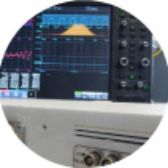High Precision Localization and Clock Synchronization
Localization is a key technology in the Internet of Things, which allows a device or sensor to align with its environment (location awareness). This capability is not only needed to fuse spatial context with the aggregated data, but is also a prerequisite for the automatic configuration of networks, for example, in environmental monitoring, border control and similar sensor applications. Location determination is beneficial not only to mobile devices, but as well to stationary ones, as they too can benefit from a location awareness, for example during a reconfiguration phase.

„… in a radio location system, base stations were synchronized with a precision of 50ps by DISS over packet-oriented networks, which at the same time served to exchange data.“
The research in the field of localization done at the center focus on time- and RSS-based (Received Signal Strenght) methods complemented with directional antennas which offer great advantages in terms of interference suppression, better communication range and reduced energy consumption. In order to enable the localization of the mobile radio nodes without dedicated localization functionality, research projects customarily deal with infrastructure-based systems.
High-precision clock synchronization in (spatially) distributed systems with synchronization accuracies down to the ps range is, on the one hand, the basic enabling technology for time-based localization. On the other hand, it is also required for coordinated command execution and event detection in sensor and automation networks. Moreover, the accurate synchronization of nodes is also an elementary requirement in real-time systems using variants of the TDMA (Time Division Multiple Access) method. The research focuses on heterogeneous networks, robustness, fault tolerance and convergence with existing network technologies.
Contact: Thomas Bigler